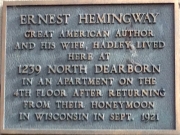1239 North Dearborn, Chicago, Illinois

“Would you mind if I took a picture of the Hemingway plaque on your building?”
I said this to the young man who had just come out of the building’s front door while I pointed to the wall across from me, far from my camera’s easy reach. I occupied a position on the sidewalk, kept from getting any closer by an inhibiting black metal fence capped with spikes, like the tops of jousting spears.
“Sure,” he said, smiling. He walked toward me and unlocked the gate. “Come in so you can get a better look.”
So much had happened for Ernest Hemingway in this city. Chicago was where he met Hadley Richardson, who became his first wife, and made friends with his great literary mentor Sherwood Anderson, who advised him to take the all-important step of moving to Paris to ensconce himself in the artistic community inventing what it meant to be modern.
Although Ernest lived in Chicago for only a short time—from October 1920 until December 1921—the city shaped his life in a number of ways. It was there the budding author learned how to write about vice. In an article for the Toronto Star he declared Chicago the new Wild West and, in another, explained that during elections candidates and their supporters tended to be killed. While in Chicago he also witnessed the unfolding of a great American scandal: proof of corruption in the National pastime, with the trial of the “Black Sox” and the banishment of those eight baseball players from the game for life.
When Ernest moved to what is known as ‘The Windy City,’ the metropolis at the heart of a sprawling expanse of suburbs that included his own birthplace of Oak Park, he initially lived with friends. But in the summer of 1921, as a young man of twenty-two about to be married, he began to look for an apartment to share with his bride. He wrote Hadley about an apartment on North Dearborn, enclosing a picture of what he had found.
Hadley wrote back to say she’d had a dream about decorating their small, attic apartment. She was enchanted. In the dream, Hadley pictured a space with a sewing machine, a piano, shelves full of books, and “thousands of pillows.”
When she woke up, she realized this would be an apartment not just for herself but for the two of them. It would also need to contain things necessary for him to be happy. A daydream revealed to her “a place for the typewriter and table under the window with a light to come over your left shoulder.”
Ernest sent Hadley a floor-plan. She responded with great excitement. Owing to the fact the apartment had been carved out of what had once been a stand-alone home, there was certain quirkiness to the place. That pleased her; she thought the apartment’s irregularly shaped rooms would give it character.
As I positioned my camera in front of the plaque on the building’s front wall, I told the young man a bit about Ernest and Hadley’s time in Chicago. I pressed the shutter-release button several times, hoping at least one photo would clearly reproduce the text, which read:
Ernest Hemingway
Great American Author
and his wife, Hadley, Lived
here at
1239 North Dearborn
In an apartment on the
4th floor After returning
from their honeymoon
in Wisconsin In Sept. 1921
The young man was clearly heading out somewhere when he emerged from his own home, but seeing my evident interest in the Hemingway plaque he kindly said, “Would you like to see inside?”
To be continued in Part II
Works Cited
Hamilton, Sharon. “Ernest Hemingway and the Black Sox Trial.” Society for American Baseball Research Black Sox Scandal Committee Newsletter Dec. 2020 sabr.org/research/article/ernest-hemingway-and-the-black-sox-trial/
Hamilton, Sharon. Interview. “Hemingway and Baseball.” OneTruePodcast. 11 Oct. 2021. www.hemingwaysociety.org/node/954
Hemingway, Ernest. “Gunmen’s Wild Political War in Chicago” The Toronto Star Weekly 28 May 1921. ehto.thestar.com/marks/gunmens-wild-political-war-in-chicago
Hemingway, Ernest. “The Wild West is Now in Chicago,” The Toronto Star Weekly 6 Nov. 1920. ehto.thestar.com/marks/the-wild-west-is-now-in-chicago
Richardson, Hadley to Ernest Hemingway, Letter. 14 Aug. 1921, John F. Kennedy Presidential Library and Museum. Qtd in Gioia Diliberto, Paris Without End . Harper Perennial, 2011. Ebook.
Richardson, Hadley to Ernest Hemingway, Letter. 19 Aug. 1921. John F. Kennedy Presidential Library and Museum.
Sharon Hamilton is a member of the Hemingway Society Board. Her work on Hemingway appears in Hemingway in Comics and Teaching Hemingway and Modernism, and she was a guest for the OneTruePodcast episode on Hemingway and Baseball. She has blogged previously for the Hemingway Society about Hemingway and the 1921 baseball season.